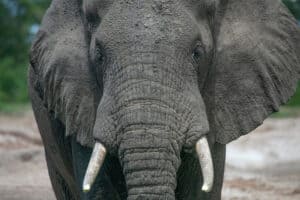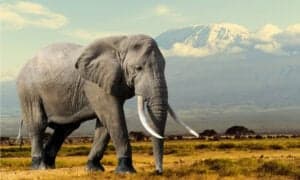Today, elephants dominate the mammal world in size. As the largest terrestrial mammal on Earth, elephants have fascinated thousands of scientists across generations. Not only are the elephants of modern times interesting, but elephants of ancient times are also natural wonders that extend the focus of current research back millions of years. Extinct species we discover and learn about creates a window to the prehistoric natural world that helps us understand the one we live in now. In this article, we will investigate 3 extinct species of elephants that were the ancestors of the beautiful beasts we see today.
What are Elephants?

Elephants are the largest mammals on land.
©Volodymyr Burdiak/Shutterstock.com
Modern elephants and their extinct ancestors belong to the taxonomic superfamily Elephantoidea. All living elephant species and some extinct ones belong to the family Elephantidae. Impressively, the earliest members of the elephant superfamily were roaming the earth as far back as the Miocene, the epoch extending from 23.03 to 5.333 million years ago! The elephant species alive today are two African species and an Asian species: the African forest elephant (Loxodonta cyclotis), the African bush elephant (Loxodonta africana), and the Asian elephant (Elephas maximus).
Size
One of the most fascinating traits of elephants is their incredible size. Elephants, specifically African bush elephants, are the largest mammals on land! Amongst all mammals, elephants are the second largest in the world with the blue whale in the first position. An African bush elephant typically weighs around 13,200 pounds for males. Females, which are much smaller are 6,600 pounds on average. For some point of reference, the heaviest males therefore can weigh more than four Ford F150 pickup trucks!
Another measure of size in many animals is shoulder height: the height from the ground to the top of an animal’s shoulder blade. A male African bush elephant has a shoulder height of up to 13 feet! Females clock in with a still massive 8 feet 6 inches. In comparison, the average riding horse has a shoulder height of 5 feet 3 inches. There is some variation in size amongst living elephant species, especially African versus Asian elephants, and the African bush elephant is the largest.
Unique Characteristics
Other characteristics of elephants to note are their unique ears, feet, trunks, and tusks. Elephants have large ears and incredible hearing ability. They can communicate at a number of frequencies inaudible to the human ear (infrasonic frequencies) and can produce extremely loud sounds as well. They can also communicate using seismic signals with their incredibly sensitive feet. Sensing the seismic activity also may involve delicate inner ear features.
A cool feature of elephant trunks and tusks is their versatility. The trunks are important for communication, feeding, drinking, keeping the animal cool by spraying water, lifting heavy items, and aggressive interactions with predators or other elephants. Their tusks also aid in such confrontations and develop early in infant males and females. Elephant tusks serve many purposes and continue to grow their entire life. The African elephant’s tusks have an average length of 6 feet and a record length of 11 and a half feet!
What are the Causes of Extinction for Past Elephant Species?
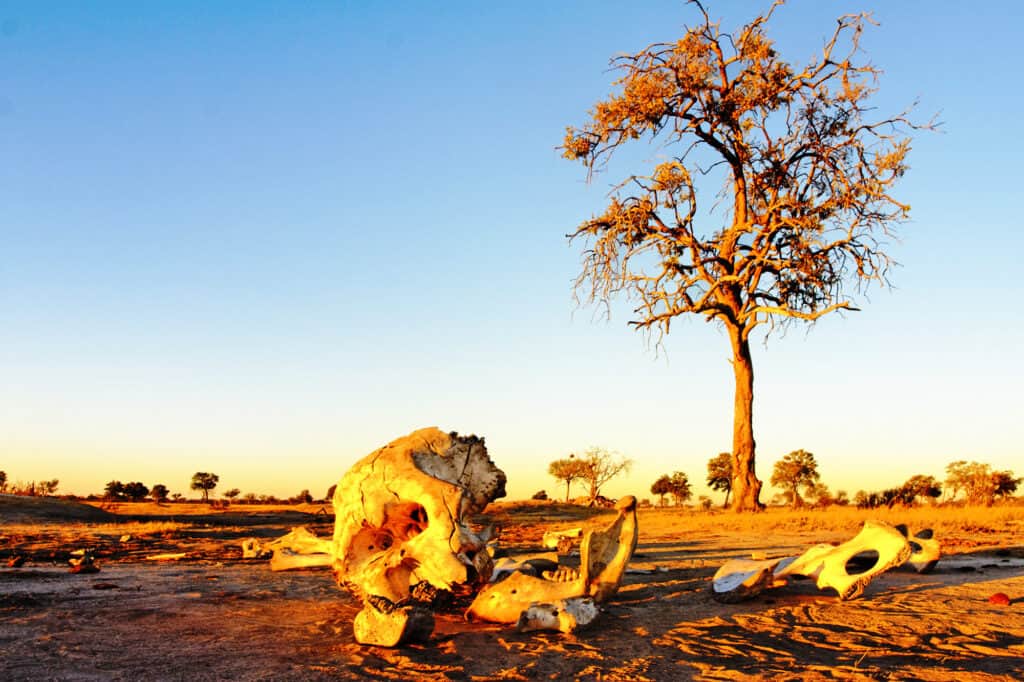
Increase in global temperature was a major reason for extinction.
©SouWest Photography/Shutterstock.com
Quaternary Extinction Event
During the Late Pleistocene, a mass extinction called the Quaternary Extinction Event occurred. During this time, many of the Pleistocene megafauna species became extinct. The Pleistocene megafauna included terrestrial animals that were particularly large, such as various mammoth species, short-faced bears, saber-tooth cats, and more. Scientists debate the exact beginning and end of this event, but it likely peaked between 14,000 and 11,500 years ago. Numerous megafauna species became extinct in Africa and Eurasia, in the Americas, and especially on islands. Many early species of elephants became extinct including some mammoth species and the potential ancestor of the African bush elephant.
The causes of this event are debated today but likely include multiple factors. The first hypothesis is that the rapid increase in the global temperature was the cause of the mass extinction. By this logic, the warming following an ice age was quicker and more severe than what many large animals could adapt to. Large animal bodies generally have evolved a low surface area to volume ratio so there is less surface (skin) exposed to cold environments relative to their volume as to keep them warm. Consequently, however, there is also less surface that can radiate heat and sweat to cool the animal down. Therefore, large animals adapted for cold weather were unable to thermoregulate as the atmosphere rapidly became hotter. Other theories for an environmental cause of this extinction event relate to the spread of disease, the cascading effects following the loss of a keystone species, changes in weather, and vegetation changes.
Hunting Pressures
Another cause of extinction in many past elephant species that also weighs on elephants today is human hunting. The hunting of elephant species for food, hides, trophies, and their precious ivory tusks has a long history in the human relationship with elephants. Hunting pressures by early humans on now-extinct mammoth species were no small threat either. The hunting of certain animals that hold substantial ecological roles can cause a chain reaction in their ecosystem with the potential to affect many species.
The woolly mammoth was a keystone species just as modern elephants are keystone species today. This means that the elimination of the woolly mammoth would have caused the extinction of several other animals, too. Potentially even causing a mass extinction event. This is because many elephants eat woody plants and small trees. They also crush such plants as they make paths through vegetated areas. If the woolly mammoth was hunted to extinction, woody plant species would take over and the other habitats at the time would become forested. The grass species that grazing herbivores relied on would have no space to grow and would be overrun. The herbivores would have no food and would either adapt or die out. Similarly, with fewer herbivores, many predator species would go extinct as their food source became extinct. It may seem dramatic that the hunting of one animal can cause the extinction of many; but a chain reaction following the extinction of the mammoth is a plausible theory for the cause of extinction of many ancient elephant species.
Let’s meet some of the elephant species that have gone extinct!
1. Palaeoloxodon recki
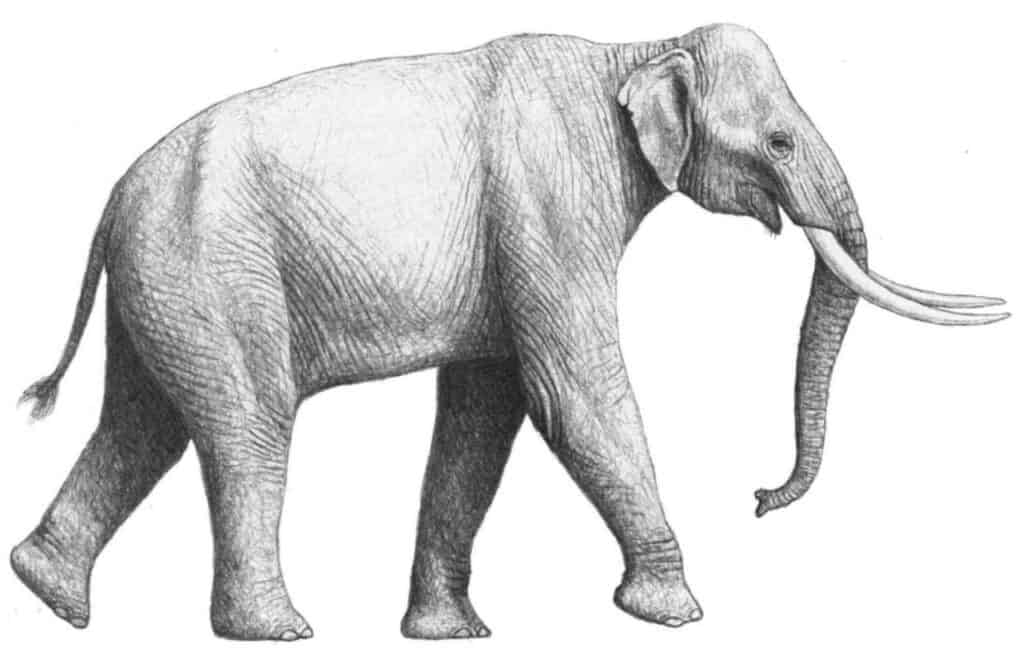
was a very large ancient elephant.
The first cool extinct species of elephant that we will take a closer look at is Palaeoloxodon recki. This ancient elephant was potentially the largest elephant that has ever walked the earth! It had a shoulder height of 14 feet, which is 4 feet taller than the largest elephant species alive today! In fact, one weight estimation for an adult male Palaeoloxodon recki was approximately 27,200 pounds! These elephants were a grass-eating species, unlike woolly mammoths. Scientists speculate that its appearance, aside from total size, was relatively close to elephants today.
History and Extinction
Palaeolodoxon recki was alive during the Pliocene and Pleistocene. These epochs together span the timeframe 5.33 to 0.0117 million years ago. The likely cause of extinction of this species was competition with other elephant species. Elephants of the Loxodonta genus, which included contemporary extinct species and now includes modern African species, were in competition with Palaeolodon recki for resources. The ancient species of Loxodonta elephants supplanted Palaeolodon recki and its descendant species over time.
2. Pygmy Elephant (Palaeoloxodon falconeri)
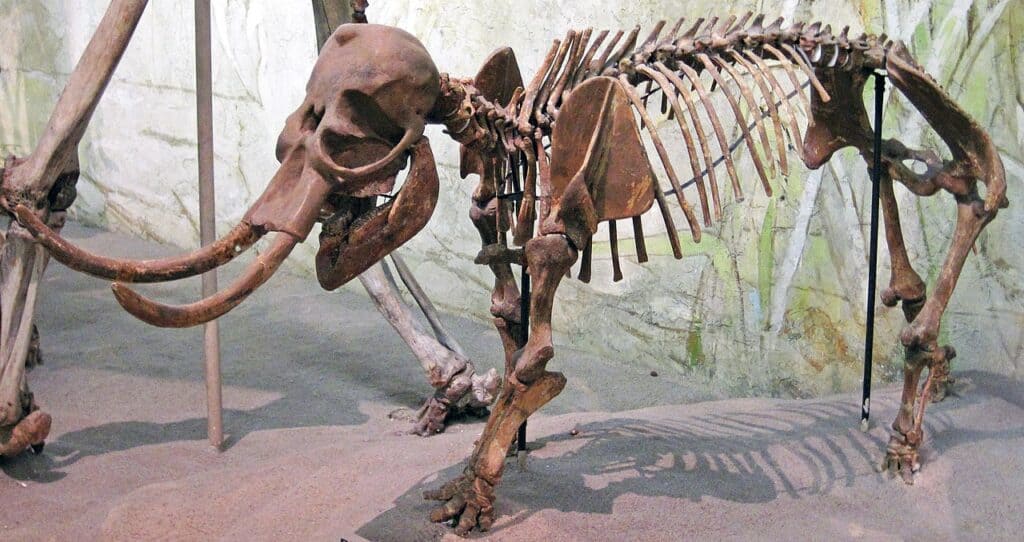
Pygmy elephants were the smallest elephants.
The second cool extinct species of elephant is commonly called the pygmy elephant. This is an appropriate nickname for Palaeoloxodon falconeri because, in contrast to our last elephant, it is the smallest elephant that has ever existed! A male pygmy elephant specimen was 3 feet 2 inches tall at the shoulder and a female was 2 feet 8 inches. This miniature species is an example of insular dwarfism. If a subgroup of a species becomes isolated, for example on an island, apart from its origin population, it will face new selective pressures and evolve differently over geological time from the mainland species. For example, islands tend to lack large predatory mammals. If a subpopulation of elephants came to inhabit an island, the evolutionary forces they would face would be different than the elephants on the mainland contending with a different predator. The traits allowing survival and successful reproduction would be different and what was advantageous to one population, would not be advantageous to the other.
The absence of large predators on islands leaves an ecological niche open. A new species can rise to fill that space as a top predator. With a new predator present, it may be advantageous for other prey species to be small. If smaller animals are better able to evade their predator, they will reproduce more, and the species will evolve to be smaller over generations. Another adaptive response to a new predator is the opposite trend- an increase in size. If larger prey animals are harder to take down and can fight back, they may evolve to be larger.
Scientists still debate the reason for the pygmy elephant’s small size, but the rise of a new predator species that was different from the mainland species could have been an important factor.
History and Extinction
The pygmy elephant was alive mostly during the Middle Pleistocene which spans 774,000 to 129,000 years ago. The pygmy elephant first arrived in Europe, however, about 800,000 years ago. These elephants were inhabiting Sicily, Malta, and potentially smaller surrounding islands. It is unknown when exactly the pygmy elephant became extinct and why. Other dwarf species separate from Palaeodoxon falconeri also inhabited Italy and Malta, and additionally Greek and Indonesian islands. Some of these species were contemporary with the pygmy elephant and shared a similar geographical range.
3. Woolly mammoth (Mammuthus primigenius)
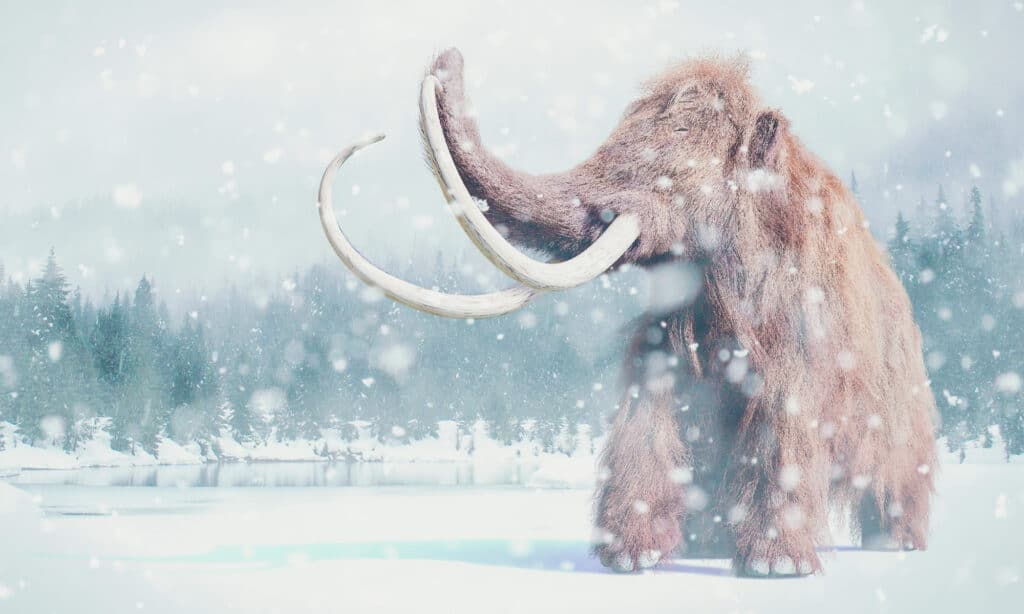
Wooly mammoths are recognizable prehistoric animals.
©Dotted Yeti/Shutterstock.com
The final cool extinct species of elephant is the woolly mammoth! It is arguably one of the most recognizable prehistoric animals. This animal is a staple example of Pleistocene megafauna. Males had a shoulder height measuring 8.9 to 11.2 feet and could weigh up to 13,200 pounds! Females had a shoulder height of 8.5 feet to 9.5 feet and weighed 8,800 pounds. They were smaller than modern African elephants, but their size was still very impressive. In fact, woolly mammoth babies were on average 200 pounds at birth! For reference, the average human baby at birth is only between 5 and 8 pounds and the average full-grown man is around 197 pounds.
The woolly mammoth had a heavy coat of fur that covered its entire body. It also had small ears and a small tail to minimize heat loss and reduce the likelihood of frostbite. Males and females both had large tusks, unlike Asian elephants today who occasionally have stunted or absent tusks. Woolly mammoths had a distinct, dome-shaped head and a large hump between their shoulders.
History and Extinction
Woolly mammoths belong to the family Elephantidae and the subfamily Elephantinae. As we talked about before, many species of mammoths and other elephants in these groups became extinct during the Quaternary Extinction Event including woolly mammoths. Mammoth species broadly were alive between 5 and 0.0037 million years ago. In addition to woolly mammoths, there were 9 other mammoth species that span this time frame. Woolly mammoths were one of the latest to arise, living between 400,000 and 4,000 years ago.
The closest living relative of the woolly mammoth is the Asian elephant. Evidence of woolly mammoths first appearing in the archaeological record are from East Asia. Interestingly, the woolly mammoth is one of the most extensively studied prehistoric animal. This is because frozen carcasses with minimal decomposition have been found in Siberia and North America. There are also many depictions of woolly mammoths in cave paintings.
Summary of 3 Extinct Species of Elephant
| Number | Elephant | When They Lived |
|---|---|---|
| 1 | Palaeoloxodon recki | 5.33 to 0.04 million years ago |
| 2 | Palaeoloxodon falconeri (pygmy elephant) | 774,000 to 129,000 thousand years ago |
| 3 | Mammuthus primigenius (wooly mammoth) | 400,000 to 4,000 thousand years ago |
The photo featured at the top of this post is © iStock.com/Aunt_Spray
Thank you for reading! Have some feedback for us? Contact the AZ Animals editorial team.




